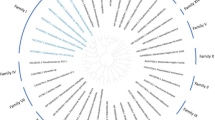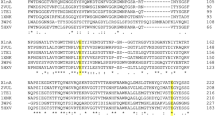Abstract
Arabidopsis thaliana cell wall invertase 1 (AtcwINV1) and Thermotoga maritima β-fructosidase (BfrA) are among the best structurally studied members of the glycoside hydrolase family 32. Both enzymes hydrolyze sucrose as the main substrate but differ strongly in their thermal stability. Mesophilic AtcwINV1 and thermophilic BfrA have divergent sequence similarities in the N-terminal five bladed β-propeller catalytic domain (31 %) and the C-terminal β-sandwich domain (15 %) of unknown function. The two enzymes were subjected to 200 ns molecular dynamics simulations at 300 K (27 °C) and 353 K (80 °C). Regular secondary structure regions, but not loops, in AtcwINV1 and BfrA showed no significant fluctuation differences at both temperatures. BfrA was more rigid than AtcwINV1 at 300 K. The simulation at 353 K did not alter the structural stability of BfrA, but did increase the overall flexibility of AtcwINV1 exhibiting the most fluctuating regions in the β-propeller domain. The simulated heat treatment also increased the gyration radius and hydrophobic solvent accessible surface area of the plant enzyme, consistent with the initial steps of an unfolding process. The preservation of the conformational rigidity of BfrA at 353 K is linked to the shorter size of the protein loops. Shortening of BfrA loops appears to be a key mechanism for thermostability.









Similar content being viewed by others
References
Cantarel BL, Coutinho PM, Rancurel C, Bernard T, Lombard V, Henrissat B (2009) The Carbohydrate-Active EnZymes database (CAZy): an expert resource for glycogenomics. Nucleic Acids Res 37(Database issue):D233–D238
Alberto F, Bignon C, Sulzenbacher G, Henrissat B, Czjzek M (2004) The three-dimensional structure of invertase (beta-fructosidase) from Thermotoga maritima reveals a bimodular arrangement and an evolutionary relationship between retaining and inverting glycosidases. J Biol Chem 279(18):18903–18910
Nagem RA, Rojas AL, Golubev AM, Korneeva OS, Eneyskaya EV, Kulminskaya AA, Neustroev KN, Polikarpov I (2004) Crystal structure of exo-inulinase from Aspergillus awamori: the enzyme fold and structural determinants of substrate recognition. J Mol Biol 344(2):471–480
Verhaest M, Le RK, Sansen S, De CB, Lammens W, De Ranter CJ, Van Laere A, Van den Ende W, Rabijns A (2005) Crystallization and preliminary X-ray diffraction study of a cell-wall invertase from Arabidopsis thaliana. Acta Crystallogr Sect F: Struct Biol Cryst Commun 61(Pt 8):766–768
Verhaest M, Lammens W, Le RK, De CB, De Ranter CJ, Van Laere A, Van den Ende W, Rabijns A (2006) X-ray diffraction structure of a cell-wall invertase from Arabidopsis thaliana. Acta Crystallogr D Biol Crystallogr 62(Pt 12):1555–1563
Lammens W, Le RK, Schroeven L, Van LA, Rabijns A, Van den Ende W (2009) Structural insights into glycoside hydrolase family 32 and 68 enzymes: functional implications. J Exp Bot 60(3):727–740
Witarto AB, Sode K (2001) Increasing the hydrophobic interaction between terminal W-motifs enhances the stability of Salmonella typhimurium sialidase. A general strategy for the stabilization of beta-propeller protein fold. Protein Eng 14(11):891–896
Kotwal SM, Shankar V (2009) Immobilized invertase. Biotechnol Adv 27(4):311–322
Sturm A (1999) Invertases. Primary structures, functions, and roles in plant development and sucrose partitioning. Plant Physiol 121(1):1–8
Munoz-Gutierrez I, Rodriguez-Alegria ME, Lopez-Munguia A (2009) Kinetic behaviour and specificity of beta-fructosidases in the hydrolysis of plant and microbial fructans. Process Biochem 44:891–898
Liebl W, Brem D, Gotschlich A (1998) Analysis of the gene for beta-fructosidase (invertase, inulinase) of the hyperthermophilic bacterium Thermotoga maritima, and characterisation of the enzyme expressed in Escherichia coli. Appl Microbiol Biotechnol 50(1):55–64
Menendez C, Martinez D, Trujillo LE, Mazola Y, Gonzalez E, Perez ER, Hernández L (2012) Constitutive high-level expression of a codon-optimized beta-fructosidase gene from the hyperthermophile Thermotoga maritima in Pichia pastoris. Appl Microbiol Biotechnol 97(3):1201–1212
Martinez D, Cutino-Avila B, Perez ER, Menendez C, Hernandez L, Del Monte-Martinez A (2014) A thermostable exo-beta-fructosidase immobilised through rational design. Food Chem 145:826–831
de Coninck B, le Roy K, Francis I, Clerens S, Vergauwen R, Halliday AM, Smith SM, Van Laere A, Van den Ende W (2005) Arabidopsis AtcwINV3 and 6 are not invertases but are fructan exohydrolases (FEHs) with different substrate specificities. Plant, Cell &Environment 28(4):432–443
Alberto F, Jordi E, Henrissat B, Czjzek M (2006) Crystal structure of inactivated Thermotoga maritima invertase in complex with the trisaccharide substrate raffinose. Biochem J 395(3):457–462
Lammens W, Le RK, Van LA, Rabijns A, Van den Ende W (2008) Crystal structures of Arabidopsis thaliana cell-wall invertase mutants in complex with sucrose. J Mol Biol 377(2):378–385
Scheraga HA, Khalili M, Liwo A (2007) Protein-folding dynamics: overview of molecular simulation techniques. Annu Rev Phys Chem 58:57–83
Butterwick JA, Loria JP, Astrof NS, Kroenke CD, Cole R, Rance M, Palmer AG 3rd (2004) Multiple time scale backbone dynamics of homologous thermophilic and mesophilic ribonuclease HI enzymes. J Mol Biol 339(4):855–871
Tang L, Liu H (2007) A comparative molecular dynamics study of thermophilic and mesophilic ribonuclease HI enzymes. J Biomol Struct Dyn 24(4):379–392
Zavodszky P, Kardos J, Svingor PGA (1998) Adjustment of conformational flexibility is a key event in the thermal adaptation of proteins. Proc Natl Acad Sci U S A 95(13):7406–7411
Bae E, Phillips GN Jr (2006) Roles of static and dynamic domains in stability and catalysis of adenylate kinase. Proc Natl Acad Sci U S A 103(7):2132–2137
Purmonen M, Valjakka J, Takkinen K, Laitinen T, Rouvinen J (2007) Molecular dynamics studies on the thermostability of family 11 xylanases. Protein Eng Des Sel 20(11):551–559
Berman HM, Battistuz T, Bhat TN, Bluhm WF, Bourne PE, Burkhardt K, Feng Z, Gilliland GL, Iype L, Jain S, Fagan P, Marvin J, Padilla D, Ravichandran V, Schneider B, Thanki N, Weissig H, Westbrook JD, Zardecki C (2002) The protein data bank. Acta Crystallogr D Biol Crystallogr 58(Pt 6 No 1):899–907
Holm L, Rosenstrom P (2010) Dali server: conservation mapping in 3D. Nucleic Acids Res 38:W545–W549
Van Der Spoel D, Lindahl E, Hess B, Groenhof G, Mark AE, Berendsen HJ (2005) GROMACS: fast, flexible, and free. J Comput Chem 26(16):1701–1718
Jorgensen WL, Tirado-Rives J (1988) The OPLS [optimized potentials for liquid simulations] potential functions for proteins, energy minimizations for crystals of cyclic peptides and crambin. J Am Chem Soc 110(6):1657–1666
Berendsen HJC, Postma JPM, van Gunsteren WF, Hermans J (1981) Interaction models for water in relation to protein hydration. Intermolecular Forces 14:331–342
Darden T, York D, Pedersen L (1993) Particle mesh Ewald: An N · log(N) method for Ewald sums in large systems. J Chem Phys 98(12):10089–10092
Essmann U, Perera L, Berkowitz ML, Darden T, Lee H, Pedersen LG (1995) A smooth particle mesh Ewald potential. J Chem Phys 103:8577–8592
Humphrey W, Dalke A, Schulten K (1996) VMD: visual molecular dynamics. J Mol Graph 14(1):33–38
Pettersen EF, Goddard TD, Huang CC, Couch GS, Greenblatt DM, Meng EC, Ferrin TE (2004) UCSF Chimera—a visualization system for exploratory research and analysis. J Comput Chem 25(13):1605–1612
Fetrow JS (1995) Omega loops: nonregular secondary structures significant in protein function and stability. FASEB J 9(9):708–717
Balasco N, Esposito L, De SA, Vitagliano L (2013) Role of loops connecting secondary structure elements in the stabilization of proteins isolated from thermophilic organisms. Protein Sci 22(7):1016–1023
Vieille C, Zeikus GJ (2001) Hyperthermophilic enzymes: sources, uses, and molecular mechanisms for thermostability. Microbiol Mol Biol Rev 65(1):1–43
Grottesi A, Ceruso MA, Colosimo A, Di NA (2002) Molecular dynamics study of a hyperthermophilic and a mesophilic rubredoxin. Proteins 46(3):287–294
Hernandez G, Jenney FE Jr, Adams MW, LeMaster DM (2000) Millisecond time scale conformational flexibility in a hyperthermophile protein at ambient temperature. Proc Natl Acad Sci U S A 97(7):3166–3170
Motono C, Gromiha MM, Kumar S (2008) Thermodynamic and kinetic determinants of Thermotoga maritima cold shock protein stability: a structural and dynamic analysis. Proteins 71(2):655–669
Wintrode PL, Zhang D, Vaidehi N, Arnold FH, Goddard WA III (2003) Protein dynamics in a family of laboratory evolved thermophilic enzymes. J Mol Biol 327(3):745–757
D'Auria S, Herman P, Lakowicz JR, Tanfani F, Bertoli E, Manco G, Rossi M (2000) The esterase from the thermophilic eubacterium Bacillus acidocaldarius: structural-functional relationship and comparison with the esterase from the hyperthermophilic archaeon Archaeoglobus fulgidus. Proteins 40(3):473–481
Hirano N, Haruki M, Morikawa M, Kanaya S (2000) Enhancement of the enzymatic activity of ribonuclease HI from Thermus thermophilus HB8 with a suppressor mutation method. Biochemistry 39(43):13285–13294
Matsuura T, Yomo T, Urabe I (2002) Evolutionary molecular engineering by random elongation mutagenesis. Methods Mol Biol 182:221–230
Thangapandian S, John S, Lazar P, Choi S, Lee KW (2012) Structural origins for the loss of catalytic activities of bifunctional human LTA4H revealed through molecular dynamics simulations. PLoS One 7(7), e41063
Witarto AB, Ohtera T, Sode K (1999) Site-directed mutagenesis study on the thermal stability of a chimeric PQQ glucose dehydrogenase and its structural interpretation. Appl Biochem Biotechnol 77–79:159–168
Robinson-Rechavi M, Godzik A (2005) Structural genomics of Thermotoga maritima proteins shows that contact order is a major determinant of protein thermostability. Structure 13(6):857–860
Wrba A, Schweiger A, Schultes V, Jaenicke R, Zavodszky P (1990) Extremely thermostable D-glyceraldehyde-3-phosphate dehydrogenase from the eubacterium Thermotoga maritima. Biochemistry 29(33):7584–7592
Li WF, Zhou XX, Lu P (2005) Structural features of thermozymes. Biotechnol Adv 23(4):271–281
Abedi KR, Abdul Rahman MB, Basri M, Salleh AB, Jacobs D, Abdul WH (2009) Molecular dynamics study of the structure, flexibility and dynamics of thermostable l1 lipase at high temperatures. Protein J 28(1):14–23
Day R, Bennion BJ, Ham S, Daggett V (2002) Increasing temperature accelerates protein unfolding without changing the pathway of unfolding. J Mol Biol 322(1):189–203
Lazaridis T, Lee I, Karplus M (1997) Dynamics and unfolding pathways of a hyperthermophilic and a mesophilic rubredoxin. Protein Sci 6(12):2589–2605
Seshasayee AS (2005) High-temperature unfolding of a trp-cage mini-protein: a molecular dynamics simulation study. Theor Biol Med Model 2:7
Kumar S, Tsai CJ, Nussinov R (2000) Factors enhancing protein thermostability. Protein Eng 13(3):179–191
Author information
Authors and Affiliations
Corresponding author
Additional information
This work was performed at Center of Genetic Engineering and Biotechnology (CIGB) institution.
Rights and permissions
About this article
Cite this article
Mazola, Y., Guirola, O., Palomares, S. et al. A comparative molecular dynamics study of thermophilic and mesophilic β-fructosidase enzymes. J Mol Model 21, 228 (2015). https://doi.org/10.1007/s00894-015-2772-4
Received:
Accepted:
Published:
DOI: https://doi.org/10.1007/s00894-015-2772-4




